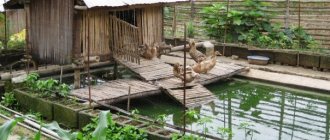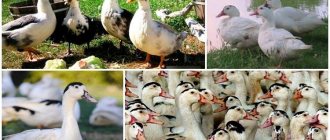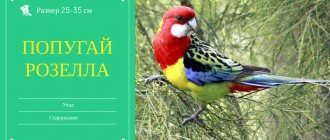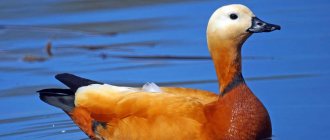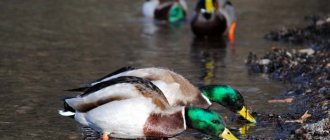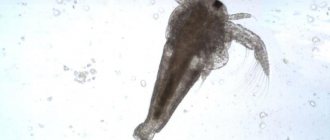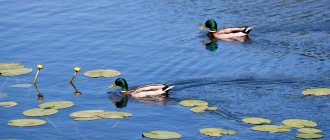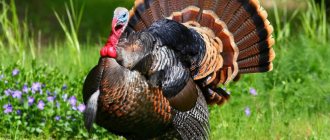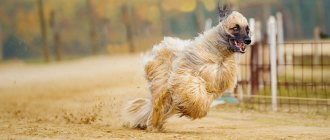Domestic ducks are of great interest for breeding in private backyards. They quickly fatten up, almost never get sick, adapt well to different climatic conditions, and eat everything they are given. The most common breed in Russia is the Peking duck; it can most often be found in private estates. This choice is not accidental: this breed is distinguished by a number of outstanding characteristics that attract many duck breeders to it. Let's look at what they are and how to properly raise this bird at home.
Origin and description
The breed was bred in Beijing in the 18th century, after which it quickly spread throughout the country and became a leader. Then it was brought from China to Europe and America, where it replaced many local breeds. This was due to the excellent productivity and high quality of their meat.
Based on the description of the Peking duck breed standard, you can imagine what its typical representative should look like:
- wide, rounded, elongated body, slightly raised in front;
- elongated head with a flat profile;
- medium length, almost straight neck;
- dark eyes, spoon-shaped beak, long, flat and wide, light yellow or orange with a white tip;
- wide, long, keelless chest;
- the back is long and wide, somewhat convex, sloping towards the tail;
- slightly raised tail consisting of closed feathers;
- rounded, without skin folds, belly;
- long, well-fitting wings;
- legs of medium length, located approximately in the middle of the body;
- The feather is thick and fits well to the body.
The plumage of Peking ducks is white, less often cream-colored, the legs are dark yellow or orange with light-colored claws.
Gross defects in the exterior: thick neck, thick beak, large, rough-type head, strongly raised body, curly plumage, curls on the neck, short body. Low weight is also considered a defect.
Appearance
The Peking duck can always be distinguished from its fellows due to its exterior features:
- strong physique;
- wide chest;
- the back is large;
- on the large head there is a characteristically convex forehead;
- the beak has a bright orange color;
- wings with good span have excellent development;
- The neck is small and not very long.
Mostly there are ducks with thick snow-white plumage, but there are also representatives with a cream color.
Productivity characteristics
Peking ducks belong to the meat breeds, they are early maturing and already in 2-2.5 months they grow so much that they become suitable for slaughter. By this age, the weight of the drake is 3 kg, the duck is slightly smaller and weighs 2.5 kg. Adult females weigh 3 kg, and males - 4 kg. Due to the similar appearance and plumage, mass is considered the main feature by which a drake can be distinguished from a duck.
In addition to meat, eggs are also obtained from Peking ducks. Young females begin laying eggs at seven months of age. During the season, each lays up to 120 eggs with an average weight of 70 g. The color of the egg shell is from white to yellowish.
Financial part
The most important thing in drawing up a business plan is to calculate expenses and income, determine the level of profitability and payback period of the project. We will provide average figures for a duck farm of 1500 individuals.
| Start-up costs | Cost in rub. | |
| 1 | Purchase of the first batch of chicks | 164 000 |
| 2 | Construction of a poultry house and landscaping | 1 350 000 |
| 3 | Purchase of equipment | 175 000 |
| 4 | Salaries and taxes | 200 000 |
| 5 | Feed supplies for 2 months | 150 000 |
| Total: | 2 039 000 |
Let's say you sell only carcasses of raised birds, except for those left for further breeding. Thus, the first profit will already bring about 750,000 rubles. In a year you can grow 5 batches, which will be 3,750,000 total income. With all the monthly expenses for keeping the birds, paying for the work of assistants, and utilities, the amount remains high enough to cover the start-up investment during the first year.
The profitability of such a business is estimated at 50-70%, which is considered a fairly high figure. If we add to this the sale of feathers, manure, eggs, small ducklings, then the profits will be much higher, which will pay off your investment in the farm in just a few months.
Video: your own farm - ducks.
Advantages and disadvantages of the breed
The advantages of this breed have long been known to those poultry farmers who have kept ducks in their households for years. They note that representatives of the breed:
- grow quickly;
- they do not pick at the food, but eat everything that is offered to them;
- withstands both cold and heat;
- can do without bodies of water;
- reach slaughter weight in a short time;
- produce good quality meat;
- Ducks have good egg production.
Disadvantages of the breed that Peking ducks demonstrate:
- sensitivity to excessive humidity;
- due to their easily excitable nervous system, they often behave restlessly, make noise and scream;
- they have fatty meat, which is not to everyone’s taste and does not suit everyone;
- females are pretty bad brood hens, so if the ducks don’t want to incubate the eggs, the ducklings will have to be hatched in an incubator.
These features of Peking ducks can be corrected to some extent, but it is impossible to get rid of them, so they must be taken into account when choosing a breed for breeding at home.
Diseases of Pekin ducks
A few words about the pathologies of Peking ducks.
Birds from the Middle Kingdom are usually diagnosed with vitamin deficiencies, coccidiosis, and enlarged goiter.
Symptoms of insufficient supply of vitamins: lethargy, refusal to feed, stunted growth. Balancing your diet with vitamins can help you avoid this problem.
An enlarged crop is the result of blockage of the crop with large pieces of food. The solution to the problem is cleaning the crop.
Coccidiosis leads to apathy and negatively affects egg production. Diagnosis is made by droppings containing blood. One of the effective preventive measures is the use of coccidine and sulfamedinine.
Breeding at home
With properly organized care, the profitability of breeding Peking ducks at home can be high. You can get ducklings either naturally or artificially, that is, lay eggs on a hen or use an incubator.
Formation of families
Duck families consist of 1 drake and 5 ducks. It is in this ratio that the herd should be formed during the breeding season. Ducks lay eggs in the spring, after which they sit on the eggs and hatch the ducklings. If they do not show interest in hatching, then there is nothing left to do but use an incubator.
You can breed not only purebred white Peking ducks, but also cross them with other breeds, for example, Indian ducks.
We recommend reading
Features of keeping Mulard ducks at home
Features of keeping Muscovy ducks at home
What to do, the ducks ate and the ducklings fall on their feet
Overview of the Bashkir duck breed, their maintenance and breeding
Natural hatching of ducklings
If, after all, the duck wants to sit on the eggs, then you need to arrange a nest for it: place a wooden box in the farthest corner of the house, spacious enough so that the eggs and the duck can easily fit in it. Incubation of eggs in Peking ducks lasts 27-29 days, during which the hen must be provided with food and water. From the second half of the incubation period, you need to place a container of water near the duck in which she will bathe. This is necessary because duck eggs need to be moistened so that the thick fatty film covering the egg wears off. If this is not possible, after the 15th day you will need to spray the incubated eggs with water every day. The hatched ducklings can be left under the hen.
Using an incubator
In most cases, an incubator is used to breed ducklings at home. Only eggs from healthy birds are suitable for laying. They must be intact, without cracks, stains of various origins, standard sizes and shapes characteristic of the breed. They should be fresh, no more than a week after demolition.
The temperature at which duck eggs are incubated must be at least 38°C in 1 week, and the humidity must be at least 70-80%. Every 8 hours they need to be turned over so that they warm up evenly under the lamps. From 8 to 14 days t 37.8°C, humidity 60%. From days 15 to 25, the parameters are left the same, but the eggs are ventilated and sprayed 2 times a day for 15-20 minutes. From 26 to 28 days - t 37.5°C, humidity 85-90%, turning over and ventilation is stopped. On the day of hatching, all ducklings should be left in the incubator until they are completely dry.
Dietary recommendations
Ducks have certain anatomical features. In view of this, food passes through their body quite quickly, because the length of the intestines is only 2 m. It takes them about 4 hours for whole grain food to pass through their body; in 3 hours they manage to digest various types of mash - wet and crushed. Hence the conclusion: to ensure rapid weight gain, the constant presence of fresh and easily accessible food is required.
Peking ducks are omnivores. They are suitable for food of plant as well as animal origin. An impressive part of the diet should consist of protein foods, since this is what ensures the good taste of meat. You can offer ducks grain mixtures, corn and barley flour, fish and meat waste, meal and cake, boiled potatoes, fresh carrots and herbs, and bone meal.
Ducks eat pasture consisting of larvae and pupae. They find them under rocks. These birds also eat small aquatic invertebrates, plants, and seeds. Sometimes they can even eat snails and small fish. They have special teeth on their beaks, which allow them to effectively grind food and filter it from the water.
If natural resources are provided in this case in insufficient quantities, ready-made feed for ducks is offered. But if possible, it is better to provide them with the opportunity to feed on insects that live in gardens and lawns. Thus, it will be possible to solve two problems at once: feeding the birds and ridding the area of pests. In no case is it recommended to give your pets fast food and dairy products, since their digestion is not adapted to such nutrition.
Caring for ducklings
The hatched ducklings need to be inspected and transferred to a separate box or brooder, where they are kept for the first few days. At this time, it is important that the chicks are warm, so a red lamp must be installed above them. For the first 5 days, the temperature should not fall below 30°C, then for another 5 days it should not drop below 25°C, after which it is reduced to 20°C within 3 weeks. From 2 weeks of age, ducklings can be released into fresh air, and from 4 weeks of age - into water. Keep the poultry house on a bedding of peat, sawdust, and sunflower husks.
In the first days of life, Peking ducklings should be fed a boiled egg with herbs and cottage cheese, then give them semolina or millet porridge with the addition of vegetables, root vegetables, garden tops, lettuce, nettles or other greens, which should be at least 1/4 of the total food weight . It is necessary to add chalk, salt, shell rock, mineral and vitamin supplements, and dairy products to the mixture. Month-old ducklings can already be fed with whole grains and bran. This diet must be followed throughout the entire period of raising ducklings for meat, until their weight at 2 months reaches 3 kg. Further feeding is not advisable, the bird slows down its growth, gets fat, and wastes feed units unwisely. In addition, then it begins to molt and the rudiments of a new feather form on the skin, which are difficult to remove from the carcass.
When to kill muskies
Fattening ducks before slaughter
The time for slaughtering birds must be selected taking into account the growth of the younger generation and the change of feathers. When the bird reaches 45 days of age, feather growth ends and molting begins. During this period, the duck that has reached the declared weight must be slaughtered.
Carrying out slaughter within the specified time frame makes further processing of the carcass easier. All turkey ducks that have not yet reached the required weight continue to be raised. Slaughter is carried out only after changing the feather.
Breeding musk ducks is a promising activity that produces good results with minimal feed costs. In the summer, ducks of this breed grow well on green feed, which can be easily found in any backyard.
Those who decide to own this breed of bird need to remember that Muscovy ducks fly well. You can deprive them of the ability to fly by trimming the flight feathers on their wings.
Features of keeping birds
In general, caring for Peking ducks is no different from caring for other breeds. Their housing should be spacious, since ducks do not like cramped spaces, dry and light. It should not be allowed to be damp or drafty, because ducks tolerate dampness and drafts much worse than cold. The birds need to be kept on thick bedding, which must be cleaned regularly and replaced every couple of months.
The temperature in the poultry house should be comfortable, not higher than 25°C in summer, and not lower than 10°C in winter. During the cold season, ducks need to turn on the lights, increasing the day length to at least 12 hours, so that they can lay eggs well.
In addition to the poultry house, the ducks need to be provided with a place for walking, where they will walk in the fresh air. It is necessary to install containers with water for bathing the birds. In summer, Peking ducks can be kept outside all day and driven into a barn only at night. If there is a pond nearby, you can drive Peking ducks there.
Approximate figures for a duck farm
Costs of keeping Peking duck
The main areas of expenses for organizing a duck farm:
- poultry house preparation;
- purchase of feed;
- purchase of duck stock.
After the poultry house is built and the initial number of ducklings is purchased, it will cost about 100 rubles to raise one bird. Of these, 80 rubles are the cost of feed and another 20 rubles are additional costs.
Thus, to raise 250 ducks, you will need 25 thousand rubles . If you want to organize a small farm on your personal plot and raise, for example, 50 birds, 5 thousand rubles will be enough for you. However, the income in this case will be small.
Feeding
The diet of Peking ducks should include whole grains of any cereal crops or mash with the addition of boiled or fresh vegetables, grated root vegetables, fruits, herbs, tops, kitchen waste, and bran. To saturate food with vitamins and minerals, you need to add chalk, crushed shells, shells, salt, and premixes. You can feed Peking ducks not only mash, but also mixed feed.
The feeding frequency is 3-4 times a day, since these ducks have an accelerated metabolism, which is considered their physiological feature. In addition to food, they should always have clean water available for drinking.
Disease Prevention
The breed we are considering is quite hardy and, with good care, rarely gets sick. The best prevention of any problems is proper equipment and regular cleaning of the poultry house, ventilation, balanced nutrition, and timely vaccination.
Important! The main danger for ducks is poor quality feed and bacteria contained in a damp and dirty environment.
Stunted growth, poor appetite and apathy can be caused not only by illness, but also by a simple lack of vitamins.
More serious problems include crop blockage (if the bird has swallowed something sticky or large), coccidiosis, aspergillosis, pasteurellosis and even cholera.
These diseases manifest themselves in different ways, but you should not try to make a diagnosis yourself; it is better to consult a veterinarian. However, as has been said, most of these problems arise due to poor hygiene, poor nutrition and ignorance of vaccinations.
Farmer reviews
Nikolay, 35 years old, Vladivostok
Peking duck is the best meat breed. I recommend it to everyone for breeding! The weight of the finished gutted carcass is more than 2 kg. The meat is tender, tasty, soft, not greasy. Suitable for dietary purposes. However, during maintenance, special attention should be paid to the food. The growth and development of ducklings will depend on high-quality feed. The better the quality of the food, the faster the ducklings will grow and gain the required weight. I noticed that with good food, chicks are less susceptible to all sorts of diseases.
Arthur, 40 years old, Aleksandrovsk
I want to say that no matter how much I planted the Peking duck so that it would raise offspring, there was no point. And all because Beijing women have a reduced maternal instinct. Therefore, to breed friendly offspring, I use a special incubator. Viable chicks: 10 eggs laid produce 8 ducklings. The rapid growth of chicks covers all the costs of their maintenance, since at the age of 2 months they can be slaughtered and get good meat with excellent taste. In 1 season you can raise 3 offspring.
Video about the breed:
